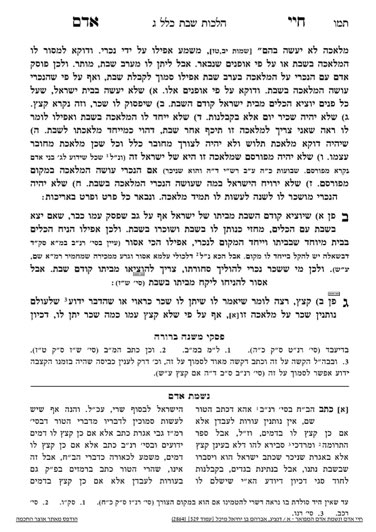We are continuing in our introduction to the halachos of amira l’akum. Yesterday, we learned that there are a few explanations behind the issur of amira l’akum. One reason, which does not apply here, is the issur of discussing melacha on Shabbos itself. (This reason does not apply over here as the Chayei Adam is discussing erev Shabbos and arrangements done on erev Shabbos for Shabbos, not arrangements done on Shabbos itself.) The second reason we learned is from the Rambam, who writes that amira l’akum is assur because people will lose their awe for the sanctity of Shabbos and eventually come to perform melacha on their own. Frinally, Rashi says that the reason amira l’akum is assur is because the non-Jew becomes the shliach of the Jew.
Although the Rambam and Rashi appear to give different reasons for the issur, it is possible that they are not arguing. There are two parts to every takana. A) Chazal always have a motivation behind their takanos, whether they reveal that reason to us or not. The Torah tells us veshamru es mishmarti, which Chazal understand to mean that Hashem is instructing Chazal that they can (and should) create fences and protective measures around the mitzvos of the Torah. B) In addition, we have a concept that chachamim ke’ein deoraysa tikun, when Chazal set up a prohibition, they follow the framework of the mitzvos of the Torah. In other words, besides the “why” of their takana, there is the “how”–by what authority and through which framework–will they create their takana.
If so, Rashi is discussing a different point than the Rambam. The Rambam is discussing the “why” of the takana, that Chazal were concerned for the erosion of the correct attitude towards Shabbos. On the other hand, Rashi is discussing the “how”, the practical problem with the scenario of a non-Jew working for a Jew on Shabbos. Rashi is explaining that the halachic framework which was used to create the prohibition was the framework of shlichus.
This point will become relevant because the Chayei Adam will discuss the concept of shlichus, and write that the concern of amira l’akum is that the non-Jew is acting as an extension of the Jew. If so, if we can create a scenario in which the non-Jew is not acting as an extension of the Jew, but rather working on their own volition, the issur will not apply. The concern–the “why” may still apply, but the “how” will not, as such a case does not fit the framework of the issur.
Another area of concern is maris ayin. Chazal were extremely concerned about giving off the perception of a non-Jew working for a Jew, and held that it is problematic even if the non-Jew is not actually working for the Jew in an assur fashion. According to the Rambam, that the concern is that the sanctity of Shabbos will be undermined, we can understand why Chazal were so concerned about maris ayin, because it could undermine a person’s entire attitude towards Shabbos.
It is interesting to point out that even though amira l’akum is derabanan, it covers the most amount of simanim in hilchos Shabbos. In this way, it is similar to muktzah, which is also derabanan yet receives many more simanim than most of the issurei deoraysa. In general throughout halacha, issurei derabanan receive many more simanim than the issurei deoraysa. If we were transported back to the time of Moshe Rabbeinu, before all of the added takanos derabbanan, we would not recognize what Shabbos looks like!
Summary
- Amira l’akum is the issur against requesting a non-Jew to work (melacha) for a jew.
- Rambam writes the reason for the issue is so that people continue to treat Shabbos with the proper respect.
- Rashi writes the reason is because the non-Jew works as a shliach, so it is as if the Jew is performing the melacha themselves
- Although it appears that Rashi and Rambam are arguing, it could be that the Rambam is explaining the reasoning behind the takana, while Rashi is explaining the mechanism through which it works.
- Another issue is the maris ayin, which will apply even if the non-Jew is not technically working for the Jew.



